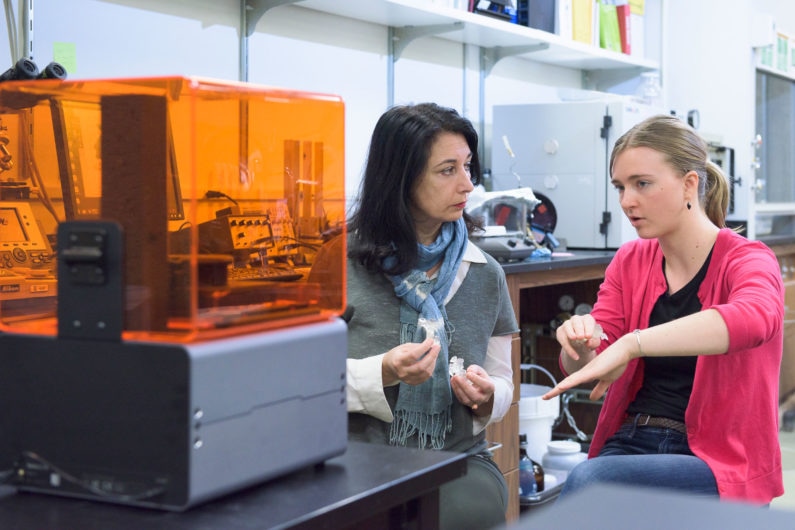Aug 11 2016
 Dulcie Head, right, and Professor Tiziana Vanorio discuss the physical models of digitally scanned rock samples made on the 3D printer at left. (Credit: L.A. Cicero)
Dulcie Head, right, and Professor Tiziana Vanorio discuss the physical models of digitally scanned rock samples made on the 3D printer at left. (Credit: L.A. Cicero)
A new 3D printing method designed by Stanford scientists could lead to the exploration of rocks that are too delicate to handle or hard to access such as those from mars or from volcanoes.
The scientists can create physical models based on digitally scanned rocks that are either hard to get, such as rocks from mars or moon, or are hard to handle due to their fragility. They have integrated two techniques namely 3D printing and remote 3D imaging for the purpose.
You could use 3D printed digital rock models to help screen and select the most scientifically interesting samples to return to Earth for research. Our study provides a first step in that direction.
Tiziana Vanorio, Assistant Professor, Stanford University
Currently, 3D printing can be helpful in analyzing the effect of microscopic structural changes of the rock in its “bulk” or large-scale characteristics such as permeability and porosity. These properties can help infer important information such as the movement of liquids like water and oil through the rocks or the physical process that affected their formation. The information can pave way for better extraction techniques.
“The advent of modern 3D printing provides an unprecedented opportunity to link the micro- and macro-scales by combining the strengths of both digital and laboratory experiments,” Vanorio said. “Three-D printing allows us to digitally manipulate changes at the pore scale and then print the rock at the scale that is suitable for laboratory tests.”
3D printing has been previously used by scientists to enlarge miniscule details of the rock’s interior structure so as to visualize them easily. “No one else has done what we did, which is digitally modify parts of a natural rock microstructure and then physically measure in a laboratory how those changes affect fluid flow in the rock,” said Dulcie Head, a Stanford doctoral candidate in Vanorio’s lab.
The idea to get three dimensional prints of rocks was triggered by the purchase of customized ballerina shoes some years ago, said Vanorio.
The company used a digital scanner to determine the exact size and shape of your feet and then 3D printed shoes that fit you like a glove. Geophysicists already digitally scan rocks, so I thought to myself ‘Why not print them, too?'
Tiziana Vanorio, Assistant Professor, Stanford University
Vanario and Head have analyzed the ability of contemporary 3D printers to recreate microscopic hallows and channels of small carbonate rocks whose digital images have been acquired by means of a CAT scanner. The details of the study will be reported in the upcoming issue of Geophysical Research Letters.
An expensive commercial 3D printer worth several thousand dollars and an industrial 3D printer that costs almost 10 times its commercial counterpart were tested by the researchers. Both models showed light-sensitive resins that are later hardened with the aid of UV light. The industrial printer, however, with its higher resolution and wax-assisted technology was able to display tiny pore spaces.
The scientists were able to show that they can alter the rock’s digital model and acquire a 3D print of the changed version. The research can be the first to enable scientists to make a direct connection between the microstructure and large-scale properties, such as permeability and porosity, of a rock. The research was selected as Science journal’s Editor’s Choice research.
A fundamental problem for geophysicists who want to understand rock properties is that our samples are not naturally comparable. You can take two rock cores from right next to each other that have very similar bulk properties, but when you look at them under a microscope, their pore structures might be completely different. By manipulating something that we couldn’t manipulate before, 3D printing allows us to understand the role of those tiny differences in the pore structure.
Dulcie Head, Doctoral Candidate, Stanford University
Head and Vanorio are positive that with advancements in the field of 3D printing, recreating other miniscule details regarding the structure of rocks is possible. They also believe that scientists will also be able to combine various materials to better recreate the various minerals that form rocks.
“There are currently printers that work with glass, metal and ceramics,” Head said. “All of those are emergent technologies, but we are hopeful that we will be able to experiment with other materials in the future.”